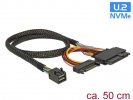Hi all,
Apologies for what is likely a stupid question, but I'm just considering installing proxmox for the below purposes and before i delve in to learning Proxmox i was hoping somebody could give me a quick steer please:
1- Homelab to study cybersecurity, including SIEM, IDS/IPS security onion, etc.
2 - NAS
3 - Plex server
My server consists of my old AMD 3950 gaming rig and purchased a 24bay rack case and 2x 8 port hba cards and 8x SATA (m/b onboard) which i intended to use as 4x ZFS z2 pools (6x drives each) and a 1TB m2 SSD which i thought i could use for the proxmox install and the VM drives?
Unless i am mistaken all the install guides i have been reading state requirements that you need 1x disk for Proxmox install, a seperate disk for the VMs and a third for the ISOs etc. which kind of ruins my future potential for a 4th z2 pool (i currently have 18 disks)
Is it not possible for me to use the 1TB disk for both proxmox and the VMs (backups to a ZFS pool)? I've also being seeing some nightmare stories about write amplification and seeing the VMs destroying consumer grade SSD's. Beginning to think UNRAID is probably a wiser choice at the moment.
Can anyone confirm if i can utilise the SSD for both hypervisor and VMs please? also if anyone has any good links or guides it would be much appreciated!
Many thanks!
G
Apologies for what is likely a stupid question, but I'm just considering installing proxmox for the below purposes and before i delve in to learning Proxmox i was hoping somebody could give me a quick steer please:
1- Homelab to study cybersecurity, including SIEM, IDS/IPS security onion, etc.
2 - NAS
3 - Plex server
My server consists of my old AMD 3950 gaming rig and purchased a 24bay rack case and 2x 8 port hba cards and 8x SATA (m/b onboard) which i intended to use as 4x ZFS z2 pools (6x drives each) and a 1TB m2 SSD which i thought i could use for the proxmox install and the VM drives?
Unless i am mistaken all the install guides i have been reading state requirements that you need 1x disk for Proxmox install, a seperate disk for the VMs and a third for the ISOs etc. which kind of ruins my future potential for a 4th z2 pool (i currently have 18 disks)
Is it not possible for me to use the 1TB disk for both proxmox and the VMs (backups to a ZFS pool)? I've also being seeing some nightmare stories about write amplification and seeing the VMs destroying consumer grade SSD's. Beginning to think UNRAID is probably a wiser choice at the moment.
Can anyone confirm if i can utilise the SSD for both hypervisor and VMs please? also if anyone has any good links or guides it would be much appreciated!
Many thanks!
G



